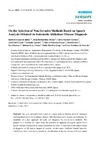Identificador persistente para citar o vincular este elemento:
https://accedacris.ulpgc.es/jspui/handle/10553/44018
| Título: | On the selection of non-invasive methods based on speech analysis oriented to automatic Alzheimer disease diagnosis | Autores/as: | López-de-Ipiña, Karmele Alonso, Jesus-Bernardino Manuel Travieso, Carlos Solé-Casals, Jordi Egiraun, Harkaitz Faundez-Zanuy, Marcos Ezeiza, Aitzol Barroso, Nora Ecay-Torres, Miriam Martinez-Lage, Pablo De Lizardui, Unai Martinez |
Clasificación UNESCO: | 3307 Tecnología electrónica | Palabras clave: | Alzheimer’s disease diagnosis; spontaneous speech; emotion recognition; machine learning; non-invasive diagnostic techniques; dementia | Fecha de publicación: | 2013 | Editor/a: | 1424-8220 | Publicación seriada: | Sensors | Resumen: | Abstract: The work presented here is part of a larger study to identify novel technologies and biomarkers for early Alzheimer disease (AD) detection and it focuses on evaluating the suitability of a new approach for early AD diagnosis by non-invasive methods. The purpose is to examine in a pilot study the potential of applying intelligent algorithms to speech features obtained from suspected patients in order to contribute to the improvement of diagnosis of AD and its degree of severity. In this sense, Artificial Neural Networks (ANN) have been used for the automatic classification of the two classes (AD and control subjects). Two human issues have been analyzed for feature selection: Spontaneous Speech and Emotional Response. Not only linear features but also non-linear ones, such as Fractal Dimension, have been explored. The approach is non invasive, low cost and without any side effects. Obtained experimental results were very satisfactory and promising for early diagnosis and classification of AD patients. | URI: | https://accedacris.ulpgc.es/handle/10553/44018 | ISSN: | 1424-8220 | DOI: | 10.3390/s130506730 | Fuente: | Sensors[ISSN 1424-8220],v. 13 (5), p. 6730-6745 |
| Colección: | Artículos |
Citas SCOPUSTM
165
actualizado el 08-jun-2025
Citas de WEB OF SCIENCETM
Citations
137
actualizado el 08-jun-2025
Visitas
91
actualizado el 27-jul-2024
Descargas
212
actualizado el 27-jul-2024
Google ScholarTM
Verifica
Altmetric
Comparte
Exporta metadatos
Los elementos en ULPGC accedaCRIS están protegidos por derechos de autor con todos los derechos reservados, a menos que se indique lo contrario.
